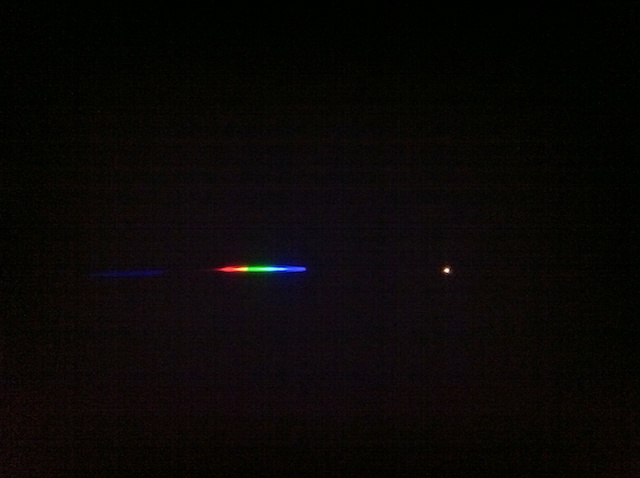
Moon Imaging, More Spectroscopy Tests
Posted: 8 October 2011
Since the skies had been cloudy for the past week+, I have been working on "modernizing" the Cassiopeia Observatory web site, as well as my other Sites. The Cassiopeia Observatory web site update has been mostly completed. You have probably already noticed some of the changes. Hopefully, I didn't break anything, but if you do come across a page that has a problem, please let me know. Thanks. You can use the "Contact" button that appears at the top of all pages on the Site to send me an email.
The skies finally cleared up again on Friday, 7 October, and at 1809 MST, I opened the observatory. The temperature was 68°F, a change of over 20° since my previous session on 28 September, the last clear night. At 1815 MST, I tried for the planet Mercury, but it was too low to be seen. I then viewed Venus through some tree branches. Venus was also low in the sky and was just a distorted blob of light. The 8" LX200-ACF telescope was then slewed to the waxing gibbous moon, high in the south-eastern sky. Viewed it with the 26mm (77X) eyepiece; seeing was lousy. Used the 15mm (133X) to do some quick terminator observing. There was too much turbulence for anything greater. At 1835 MST, I took this photo of the moon, afocal, 26mm, using the iPhone and the MX-1 afocal adapter.

I then began doing some more spectroscopy tests. A friend loaned me his Star Analyser, which is an eyepiece filter with a diffraction grating (100 lines/inch) mounted inside. I had been planning to make my own using an old filter ring, but I am trying this commercially made one first. (Thanks Jim!) The Star Analyser includes the 1.25" filter and a spacer ring to optionally adjust the grating distance from the eyepiece or imager, which increases the length of the spectrum. There is a DSLR adapter available. A Star Analyser manual is available online.
I first attached the Star Analyser to a 26mm eyepiece and tried it on the moon. Since I had no slit, the filter was not very effective on the extended object. I then slewed to the star Altair, near the zenith. This was a much better view, with the star's spectrum easily seen. However, no Fraunhofer lines were visible in the spectrum. I then began trying the filter on several eyepieces, with and without the spacer ring. Using the 5.5mm (364X) eyepiece and filter I could just detect a few lines in the star's spectrum. The lousy seeing probably hurt the viewing. With the spacer ring attached, the spectrum was further from the star and slightly larger. I also tried adding the 3X TeleXtender, but that made the view worse.
I tried some iPhone imaging of the spectrum. Here is Altair (on the right) and its spectum using a 9mm eyepiece, afocal, Star Analyser + spacer ring:

I switched to the D7000 DSLR and did some prime focus spectroscopy test images. This is a 1/2sec, ISO 1600, exposure, Star Analyser + spacer ring, showing the blazed first order spectrum on the left, the zero order star image in the middle, and another faint spectrum on the right:

This next image is cropped on just the spectrum, taken from a 1/30sec, ISO 1600, exposure:

Some lines are visible in the image. The Star Analyser manual has this spectrum imaging processing tip:
"Crop the image so it just shows the strip with the spectrum (it will typically only be a few pixels high). Resize the strip to the same width but only one pixel high, then resize again to the same width but 30 pixels high."Due to the lousy seeing on this first night trying out the Star Analyser, I have not applied this tip to the image. I do plan to use it on later spectroscopy tests with the Star Analyser. Stay tuned.
At 1950 MST, I ended the spectroscopy tests and returned to the moon for some more lunar terminator observing. The seeing had slightly improved and allowed for viewing with a 9.7mm (206X) eyepiece. I then did some D7000 DSLR, prime focus + 3X TeleXtender imaging of the terminator. These are 1/200sec, ISO 1600, exposures:



I ended lunar imaging at 2005 MST and began doing some more terminator observing. The crater Gassendi showed some nice details on the crater floor and wall during brief moments of good seeing using the 5.5mm (364X) eyepiece. This image, cropped from a 1/160sec, ISO 1600, exposure, provides a hint of these details:

I then viewed Jupiter, low in the eastern sky. Seeing was not good but the four Galilean Moons were visible as were the two equatorial cloud belts. I decided to close up for the night.
The observatory was closed at 2030 MST, 51°F.
Go to the previous report.
Return to the Cassiopeia Observatory Welcome Page.